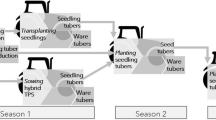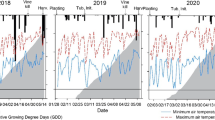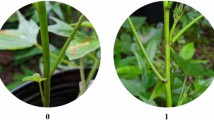Abstract
Potato (Solanum tuberosum L.) cultivars are mostly planted using similar seed piece planting depths and hill shapes even though cultivars have unique tuber and stolon characteristics. A hill-shape study was conducted at Aberdeen, Idaho to determine the effects of hill shape on yield and field-green tuber yields and quality along with stolon length and tuber spatial orientation for two potato cultivars, 'Defender' and 'Summit Russet.' Plots were planted in late April to early May. Prior to emergence four hill shapes were formed: 1) plant-and-drag, 2) broad, 3) normal, and 4) peaked. Defender had higher total yield with the broad hill, but there were no differences among the remaining three hill shapes. For Defender, U.S. No. 1 yield was lower with the plant-and-drag hill shape, and the normal and peaked hills produced lower field-green tuber yield. Hill shape had no effect on total, U.S. No. 1, or field-green tuber yields of Summit Russet. The peaked hill resulted in a deeper uppermost tuber for Defender, while the uppermost tuber was deeper in the normal and peaked hills for Summit Russet. The broad hill resulted in a larger average tuber size for Defender, but hill shape had no effect on tuber size for Summit Russet. Total number of tubers per plant, stolon length and tuber spatial orientation were not affected by hill shape for either cultivar. Hill shape and height are important considerations in maximizing yield of saleable tubers, so needs to be customized according to cultivar-dependent stolon length and tuber orientation characteristics.
Resumen
Las variedades de papa (Solanum tuberosum L.) se siembran principalmente usando profundidades de plantación y conformación del surco similares para las unidades de siembra, aun cuando las variedades tienen características únicas de tubérculo y estolón. Se condujo un estudio sobre la forma del surco en Aberdeen, Idaho, para determinar los efectos de dicha forma en rendimiento y enverdecimiento del tubérculo en el campo, respecto a rendimiento y calidad, junto con longitud de estolón y orientación espacial de tubérculo para dos variedades, “Defender” y “Summit Russet”. Los lotes se plantaron a finales de abril y a principios de mayo. Se conformaron cuatro contornos de surco antes de la emergencia. 1) plantar y tapar, 2) ancho, 3) normal, y 4) piramidal o con punta. Defender tuvo el rendimiento más alto total con el surco ancho, pero no hubo diferencias entre las restantes tres formas. Para Defender el rendimiento de la calidad U.S. No. 1 fue más bajo con la forma de plantar y tapar, y las formas normal y piramidal produjeron el rendimiento más bajo de tubérculo verde en el campo. La forma del surco no tuvo efecto en rendimiento total de tubérculo, en U.S. No. 1, o en tubérculo verde, en Summit Russet. El surco piramidal resultó en mayor profundidad preferente de tubérculo para Defender, mientras que los tubérculos prioritarios estuvieron más profundos en los surcos normales y piramidales para Summit Russet. El surco ancho resultó en un promedio de tubérculo más grande para Defender, pero la forma del surco no tuvo efecto sobre el tamaño de tubérculo para Summit Russet. El número total de tubérculos por planta, la longitud del estolón y la orientación espacial del tubérculo no se afectaron por la forma del surco en ambas variedades. La forma y la altura del surco son consideraciones importantes en la maximización del rendimiento de tubérculos vendibles, de manera que necesitan ser diseñadas de acuerdo a las características de la longitud del estolón dependiente de la variedad y a la orientación del tubérculo







Similar content being viewed by others
References
Bernik, R., T. Godesa, P. Dolnicar, and F. Vucajnk. 2009. Potato yield and tuber quality in 75 cm and 90 cm wide ridges. Acta Agriculturae Slovenica 95: 175–181.
Bohl, W.H., and S.L. Love. 2005. Effect of planting depth and hilling practices on total, U.S. No. 1, and field greening tuber yields. American Journal of Potato Research 82: 441–450.
Harms, T.E., and M.N. Konschuh. 2010. Water savings in irrigated potato production by varying hill-furrow or bed-furrow configuration. Agricultural Water Management 97: 1399–1404.
Jordan, M.O., K.A. Kelling, B. Lowery, F.J. Arriaga, and P.E. Speth. 2013. Hill shape influences on potato yield, quality, and nitrogen use efficiency. American Journal of Potato Research 90: 217–228.
King, B.A. and J.C. Stark. 1997. Potato Irrigation Management. University of Idaho Bulletin No. 789.
Kouwenhoven, J.K., U.D. Perdok, E.C. Jonkheer, P.K. Sikkema, and A. Wieringa. 2003. Soil ridge geometry for green control in French fry potato production on loamy clay soils in The Netherlands. Soil & Tillage Research 74: 125–141.
Lewis, W.C., and R.G. Rowberry. 1973. Some effects of planting depth and time and height of hilling on Kennebec and Sebego potatoes. American Potato Journal 50: 301–310.
Love, S.L., R. Novy, J. Whitworth, D.L. Corsini, J.J. Pavek, A.R. Mosley, R.E. Thornton, N.R. Knowles, S.R. James, and D.C. Hane. 2005. Summit Russet: A new russet potato variety with good fresh market and frozen processing qualities. American Journal of Potato Research 82: 425–432.
McDole, R.E., D.T. Westermann, G.D. Kleinschmidt, G.E. Kleinkopf and J.C. Ojala. 1987. Idaho Fertilizer Guide – Potatoes. University of Idaho Current Information Series No. 261.
North America Potato Variety Inventory. http://www.potatoassociation.org/Industry%20Outreach/varieties/inventory.html. Accessed May 30, 2013.
Novy, R.G., S.L. Love, D.L. Corsini, J.J. Pavek, J.L. Whitworth, A.R. Mosley, S.R. James, D.C. Hane, C.C. Shock, K.A. Rykbost, C.R. Brown, R.E. Thornton, N.R. Knowles, M.J. Pavek, N. Olsen, and D.A. Englis. 2006. Defender: A high-yielding, processing potato cultivar with foliar and tuber resistance to late blight. American Journal of Potato Research 83: 9–19.
Pavek, M.J., and R.E. Thornton. 2009. Planting depth influences potato plant morphology and economic value. American Journal of Potato Research 86: 56–67.
SAS (Statistical Analysis System). 1990. Statistical Analysis Systems Institute, Cary, NC
Tarkalson, D.D.B.A., D.L. Bjorneberg King, and J.P. Taberna Jr. 2011. Evaluation of in-row plant spacing and planting configuration for three irrigated potato cultivars. American Journal of Potato Research 88: 207–217.
Thornton, M., W. Buhrig, and N. Olsen. 2010. The relationship between soil temperature and sugar ends in potato. Potato Research 53: 289–296.
Acknowledgments
We acknowledge and thank Peggy Bain for her assistance with field work, data collection and analysis. Funding for this research project was provided, in part, by the Idaho Agricultural Experiment Station and the USDA-CSREES, and the Idaho Potato Commission.
Author information
Authors and Affiliations
Corresponding author
Rights and permissions
About this article
Cite this article
Bohl, W.H., Love, S.L. & Salaiz, T. Hill Shape Effect on Yield, Quality, Stolon Length and Tuber Orientation of Two Potato Cultivars. Am. J. Potato Res. 91, 566–572 (2014). https://doi.org/10.1007/s12230-014-9389-5
Published:
Issue Date:
DOI: https://doi.org/10.1007/s12230-014-9389-5




